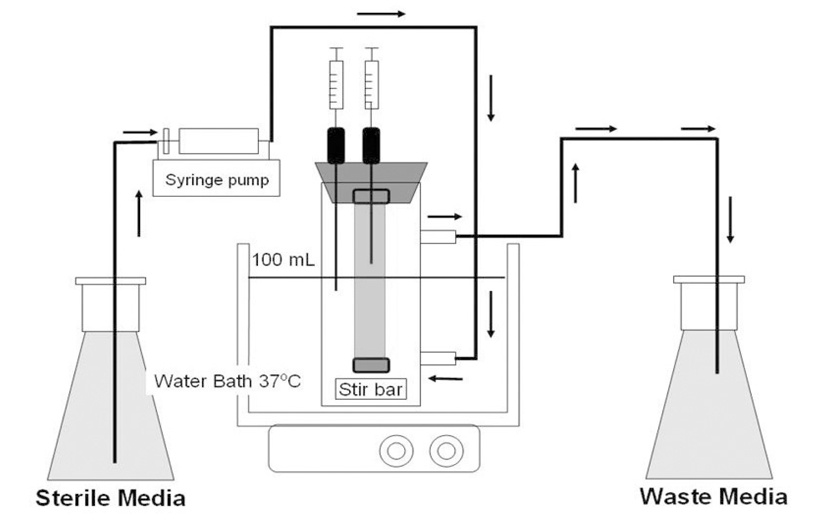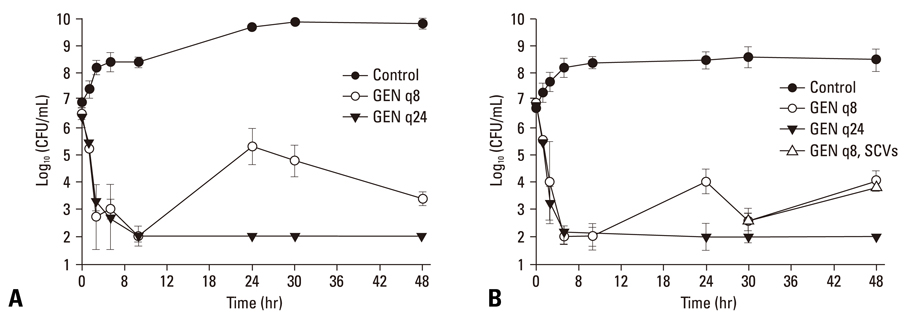Yonsei Med J.
2010 Sep;51(5):722-727. 10.3349/ymj.2010.51.5.722.
Once-Daily Gentamicin Administration for Community-Associated Methicillin Resistant Staphylococcus aureus in an in vitro Pharmacodynamic Model: Preliminary Reports for the Advantages for Optimizing Pharmacodynamic Index
- Affiliations
-
- 1Department of Internal Medicine, College of Medicine, The Catholic University of Korea, Seoul, Korea. symonlee@catholic.ac.kr
- 2Catholic Research Institutes of Medical Science, College of Medicine, The Catholic University of Korea, Seoul, Korea.
- KMID: 1071424
- DOI: http://doi.org/10.3349/ymj.2010.51.5.722
Abstract
- PURPOSE
Community-associated methicillin resistant Staphylococcus aureus (CA-MRSA) infections are increasing. Although gentamicin (GEN) is usually susceptible against CA-MRSA, GEN is rarely considered for treatment as monotherapy. We employed an in vitro pharmacodynamic model (IVPDM) to compare efficacies of GEN against CA-MRSA with two dosing regimens [thrice-daily (TD), once-daily (OD)].
MATERIALS AND METHODS
Using two strains of CA-MRSA, we adopted IVPDM comprised of two-compartments with a surface-to-volume ratio of 5.34 cm-1. GEN regimens were simulated with human pharmacokinetic data of TD and OD. Experiments were performed over 48 hours in triplicate for each strain and dosing regimen.
RESULTS
MICs of GEN for YSSA1 and YSSA15 were 1 and 2 mg/L, respectively. In OD, indices of peak/MIC were > 8.6 at least, in contrast to < 6.4 in TD. A > or = 3-log10 reduction in CFU/mL was demonstrated prior to 4 hours in TD and OD, and continued until 8 hours for both strains. However, reductions in the colony counts at 24 and 48 hours were significantly larger for OD compared to TD in both strains (p < 0.001). During TD, resistance developed in YSSA1 and small colony variants (SCVs) were documented in YSSA15. No resistance or SCVs were observed during OD in both strains.
CONCLUSION
TD and OD showed the same killing slopes until 8 hours. After the 24 hours of experiments, OD of GEN would be advantageous not only in having more reductions in colony counts, but also suppressing the development of resistance or SCVs for 48 hours.
Keyword
MeSH Terms
Figure
Reference
-
1. Fridkin SK, Hagerman JC, Morrison M, Sanza LT, Como-Sabetti K, Jernigan JA, et al. Methicillin-resistant Staphylococcus aureus disease in three communities. N Engl J Med. 2005. 352:1436–1444.
Article2. Zetola N, Francis JS, Nuermberger EL, Bishai WR. Community-acquired methicillin-resistant Staphylococcus aureus: an emerging threat. Lancet Infect Dis. 2005. 5:275–286.
Article3. Moreillon P, Que YA. Infective endocarditis. Lancet. 2004. 363:139–149.
Article4. Lee DG, Chun HS, Yim DS, Choi SM, Choi JH, Yoo JH, et al. Efficacies of vancomycin, arbekacin, and gentamicin alone or in combination against methicillin-resistant Staphylococcus aureus in an in vitro infective endocarditis model. Antimicrob Agents Chemother. 2003. 47:3768–3773.
Article5. Shelburne SA, Musher DM, Hulten K, Caesar H, Lu MY, Bhaila I, et al. In vitro killing of community-associated methcillin-resistant Staphylococcus aureus with drug combinations. Antimicrob Agents Chemother. 2004. 48:4016–4019.
Article6. Munckhof WJ, Kleinschmidt SL, Turnidge JD. Resistance development in community-acquired strains of methicillin-resistant Staphylococcus aureus: an in vitro study. Int J Antimicrob Agents. 2004. 24:605–608.
Article7. Rybak MJ, LaPlante KL. Community-associated methicillin-resistant Staphylococcus aureus: a review. Pharmacotherapy. 2005. 25:74–85.
Article8. Tsuji BT, Rybak MJ, Cheung CM, Amjad M, Kaatz GW. Community- and health care-associated methicillin-resistant Staphylococcus aureus: a comparison of molecular epidemiology and antimicrobial activities of various agents. Diagn Microbiol Infect Dis. 2007. 58:41–47.
Article9. Rybak MJ, Abate BJ, Kang SL, Ruffing MJ, Lerner SA, Drusano GL. Prospective evaluation of the effect of an aminoglycoside dosing regimen on rates of observed nephrotoxicity and ototoxicity. Antimicrob Agents Chemother. 1999. 43:1549–1555.10. Proctor RA, von Eiff C, Kahl BC, Becker K, McNamara P, Herrmann M, et al. Small colony variants: a pathogenic form of bacteria that facilitates persistent and recurrent infections. Nat Rev Microbiol. 2006. 4:295–305.11. Schaaff F, Bierbaum G, Baumert N, Bartmann P, Sahl HG. Mutations are involved in emergence of aminoglycoside-induced small colony variants of Staphylococcus aureus. Int J Med Microbiol. 2003. 293:427–435.12. Sendi P, Rohrbach M, Graber P, Frei R, Ochsner PE, Zimmerli W. Staphylococcus aureus small colony variants in prosthetic joint infection. Clin Infect Dis. 2006. 43:961–967.
Article13. Turnidge M. Pharmacodynamics and dosing of aminoglycosides. Infect Dis Clin North Am. 2003. 17:503–528.
Article14. Kim M, Nicolau DP. Nightingale CH, Ambrose PG, Drusano GL, Murakawa T, editors. Antimicrobial pharmacodynamics in theory and clinical practice. 2007. 2nd ed. New York, NY: Informa Healthcare;147–175.15. Park C, Lee DG, Kim SW, Choi SM, Park SH, Chun HS, et al. Predominance of community-associated methicillin-resistant Staphylococcus aureus strains carrying staphylococcal chromosome cassette mec type IVA in South Korea. J Clin Microbiol. 2007. 45:4021–4026.
Article16. Park C, Lee DG, Choi SM, Park SH, Choi JH, Yoo JH, et al. A case of perianal abscess due to Panton-Valentine leukocidin positive community-associated methicillin-resistant Staphylococcus aureus: report in Korea and literature review from the far east. Infect Chemother. 2008. 40:121–126.
Article17. CLSI performance standards for antimicrobial susceptibility testing; sixteenth informational supplement. 2006. Wayne, PA: Clinical Laboratory Standards Institute.18. Bonapace CR, Friedrich LV, Bosso JA, White RL. Determination of antibiotic effect in an in vitro pharmacodynamic model: comparison with an established animal model of infection. Antimicrob Agents Chemother. 2002. 46:3574–3579.
Article19. Park YH, Lee DG, Chun HS, Park C, Park SH, Choi SM, et al. Once-daily dosing of arbekacin can suppress the formation of small colony variants of methicillin resistant Staphylococcus aureus in an in vitro pharmacodynamic infection model. Infect Chemother. 2006. 38:154–163.20. Houlihan HH, Mercier RC, Rybak MJ. Pharmacodynamics of vancomycin alone and in combination with gentamicin at various dosing intervals against methcillin-resistant Staphylococcus aureus-infected fibrin-platelet clots in an in vitro infection model. Antimicrob Agents Chemother. 1997. 41:2497–2501.
Article21. von Eiff C, Peters G, Becker K. The small colony variant (SCV) concept -- the role of staphylococcal SCVs in persistent infections. Injury. 2006. 37:Suppl 2. S26–S33.22. McGrath BJ, Lamp KC, Rybak MJ. Pharmacodynamic effects of extended dosing intervals of imipenem alone and in combination with amikacin against Pseudomonas aeruginosa in an in vitro model. Antimicrob Agents Chemother. 1993. 37:1931–1937.
Article23. Barclay ML, Begg EJ, Chambers ST. Adaptive resistance following single doses of gentamicin in a dynamic in vitro model. Antimicrob Agents Chemother. 1992. 36:1951–1957.24. Domínguez MC, de La Rosa M, Borobio MV. Application of a spectrophotometric method for the determination of post-antibiotic effect and comparison with viable counts in agar. J Antimicrob Chemother. 2001. 47:391–398.
Article25. Schafer JA, Hovde LB, Rotschafer JC. Consistent rates of kill of Staphylococcus arueus by gentamicin over a 6-fold clinical concentration range in an in vitro pharmacodynamic model (IVPDM). J Antimicrob Chemother. 2006. 58:108–111.
Article26. Tam VH, Kabbara S, Vo G, Schilling AN, Coyle EA. Comparative pharmacodynamics of gentamicin against Staphylococcus aureus and Pseudomonas aeruginosa. Antimicrob Agents Chemother. 2006. 50:2626–2631.
Article27. Blaser J, Stone BB, Groner MC, Zinner SH. Comparative study with enoxacin and netilmicin in a pharmacodynamic model to determine importance of ratio of antibiotic peak concentration to MIC for bactericidal activity and emergence of resistance. Antimicrob Agents Chemother. 1987. 31:1054–1060.28. Baumert N, von Eiff C, Schaaff F, Peters G, Proctor RA, Sahl HG. Physiology and antibiotic susceptibility of Staphylococcus aureus small colony variants. Microb Drug Resist. 2002. 8:253–260.
Article29. Gavaldà J, López P, Martín T, Gomis X, Ramírez JL, Azuaje C, et al. Efficacy of ceftriaxone and gentamicin given once a day by using human-like pharmacokinetics in treatment of experimental staphylococcal endocarditis. Antimicrob Agents Chemother. 2002. 46:378–384.
Article
- Full Text Links
- Actions
-
Cited
- CITED
-
- Close
- Share
- Similar articles
-
- Community-associated methicillin-resistant Staphylococcus aureus (CA-MRSA)
- Detection of Multidrug Resistant Patterns and Associated - genes of Methicillin Resistant Staphylococcus aureus ( MRSA ) Isolated from Clinical Specimens
- A statistical analysis of methicillin-resistant staphylococcus aureus
- A case of multiple furunculosis caused by methicillin-resistant staphylococcs aureus
- A Survey for Methicillin - Resistant Staphylococcus Aureus



